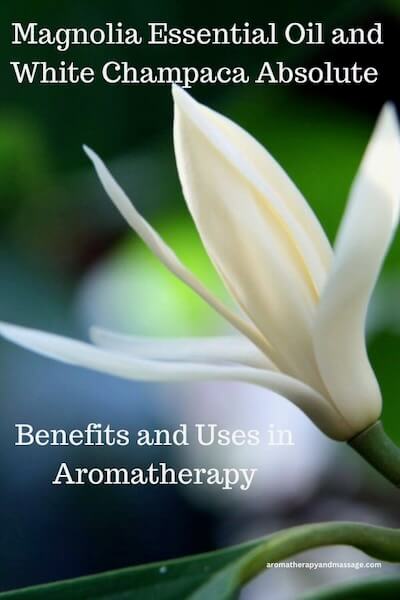- Home
- Essential Oil Profiles
- Magnolia Essential Oil
As an affiliate for Bookshop, Amazon, and other programs, I may earn a small commission for products purchased through links. This doesn't affect the price you pay. Privacy policy and disclosures.
Search this site:
Guide to Magnolia Essential Oil and Champaca Absolute
Magnolia essential oil can be a bit confusing. Here's some basic information to help. Three different oils are produced from the magnolia plant (Michelia alba or Magnolia alba):
- Magnolia flower essential oil is steam distilled from the flowers.
- Magnolia leaf essential oil is steam distilled from the leaves.
- White champaca absolute oil is solvent or CO2 extracted from the flowers.

Sometimes, you'll find magnolia flower essential oil called white champaca essential oil, which is different from white champaca absolute. Know what you are buying!
Availability of all these oils is limited.
To further confuse matters, another available oil is golden (also called yellow or orange) champaca absolute, produced from Michelia champaca (Magnolia champaca).
Also note that magnolia essential oil is produced from Magnolia graniflora (southern magnolia), which grows in hotter climates than alba.
Basic Magnolia Facts
Plant family: Magnoliaceae
Aroma: In general, fruity and floral, but varies by oil.
Perfume/Aromatic note: Middle
Is magnolia safe to use during pregnancy? Consult a professional.
Is magnolia essential oil safe for children? For kids age 6+, according to Revive Essential Oils, while Eden's Garden says age 2+. Consult a professional, as it probably depends on the type of magnolia oil.
Main components: Linalool is the main component in magnolia flower (about 70%) and leaf (about 79%) oils, and in white champaca (about 76%). The minor components vary among the oils.
In contrast, the top components of golden champaca are 2-phenylethanol and methyl linoleate.
Source: Essential Oil Safety, 2nd Edition. The book cautions magnolia flowers may be co-distilled with cheaper ylang ylang flowers to produce a less expensive oil. The book also cautions a dermal maximum of 0.9% for white champaca.
Magnolia Essential Oil Benefits and Uses
The Complete Book of Essential Oils and Aromatherapy: Magnolia flower essential oil may help relieve scars, wounds, muscle aches, abdominal cramps, fear-induced anxiety, insomnia, inability to communicate, stress-related tension, and depression.
Essential Oils: Essential Oil and Aromatherapy Recipes for Wellness, Beauty, and a Healthy Home: Magnolia flower oil is revitalizing and instills courage and confidence. The oil may help relieve abdominal cramps, anxiety, depression, insomnia, muscle aches, spasms, scars, wounds, and stress.
Here's a perfume recipe from the book:
- 10 drops magnolia flower essential oil
- 4 drops lime essential oil
- 3 drops lemon essential oil
- 3 drops sweet orange essential oil
- 2 tablespoons distilled water
- 2.5 ounces 100-proof or higher alcohol or vodka
- Blend oils in a small bowl.
- Funnel into a dark 3.5-ounce (100ml) glass spray bottle.
- Slowly add the alcohol and blend well.
- Add distilled water and gently swirl to mix.
Aromatherapy and Subtle Energy Techniques: Magnolia grandiflora essential oil increases ability to give and receive love (fourth chakra), increases ability to speak and hear about love (fifth chakra), and teaches the love and wisdom of spirit (sixth and seventh chakras).
Aromatherapeutic Blending: White champaca absolute is indicated for inflamed skin and acne and to help relieve stress and tension.
Essential Oils: A Comprehensive Handbook for Aromatic Therapy: For acne, you can blend any of the following oils with white champaca: jasmine (p. 509), vetiver (p. 527), rose (p. 547), or plai (p. 662). The oil is likely anxiety-relieving and calming.
Moisturizing Oil
- 5 drops magnolia essential oil
- 5 drops cistus essential oil
- 5 drops neroli essential oil
- 2 tablespoons hemp oil
- 4 tablespoons evening primrose oil
Blend all ingredients in a three-ounce amber glass jar. Apply a small amount to the face morning and night. Source: Eden's Garden
Shower Gel
Blend the following essential oils into eight ounces of unscented shower gel:
- 12 drops magnolia essential oil
- 12 drops eucalyptus essential oil
- 8 drops ginger essential oil
- 40 drops peppermint essential oil
To use, apply a small amount to a shower pouf or washcloth.
Source: 150 Ways to Use Essential Oils
Golden Champaca Absolute
The following information describes golden/yellow/orange champaca Michelia champaca.
The Complete Guide to Aromatherapy, Third Edition, Vol. 1: Champaca is cooling and moisturizing on the skin and is also grounding and may help reduce anger and manic depression. In Traditional Chinese Medicine, the oil regulates Heart Qi, harmonizes the Shen, and strengthens and balances the Fire Element.
The Magic of Ayurveda Aromatherapy (by Farida Irani): In ayurveda, champaca absolute has a sweet, bitter, pungent rasa (taste) and pacifies pitta and kapha but in excess increases vata. The oil helps relieve vertigo, gout, and heavy menstrual flow and is also an aphrodisiac. For the skin, champaca is cooling and may help relieve skin irritation, ulcers, sores, and allergies. Emotionally, the oil is centering and grounding, promotes abundance and prosperity, and may reduce anger and manic depression.
The Encyclopedia of Essential Oils (updated edition): Use champaca for dry, mature skin, sensitive skin, wrinkles, and general skin care. The oil may also help relieve anxiety, fear, depression, grief, insomnia, nervous debility, tension headaches, mood swing, and stress.
Aromatherapy and Subtle Energy Techniques: Champaca balances and rejuvenates the energy field and energy centers. The oils assists the third, fourth, fifth, sixth, and seventh chakras as a group to move to higher level spiritual development. For the sixth chakra. the oil opens the mind to divine energy and information and supports development of intuition.
Aromatherapeutic Blending: Champaca is indicated for inflamed, oxidized, dry, and aging skin. Consider blending the oil with rose, orange blossom, sandalwood, patchouli, and vetiver essential oils and using regenerating carriers such as avocado, blackcurrant seed, and rosehip seed.
Buy essential oils: Aromatics International or Rocky Mountain Essential Oils.
Photo Credit: Thuy Nguyen from Ho Chi Minh, Viet Nam, CC BY 2.0, via Wikimedia Commons



